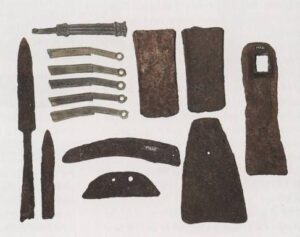Introduction
The discovery of iron led to a revolution in Indian agriculture. By the end of the Chalcolithic Age, the Indian subcontinent had been using iron for around 2500–3000 years. Now, during this time, the tools made of iron and steel were stronger and more efficient than those made of bronze. Manufacturing iron tools enhanced farming and contributed to a bigger economy.
The creation of iron farming implements greatly facilitated the agricultural process and contributed to a larger increase in farm produce. People were able to adapt to a stable existence at that time through commercial farming (trade between other nations) and subsistence farming, which helped people produce in huge amounts. Iron implements contributed to the prosperity of tiny kingdoms in a similar manner.
Indian Iron History from a Historical Perspective
In India, evidence of iron tools has been found in megalithic (big stone) burial sites. These sites in India comprised modern-day Karnataka and Kerala in the south, extended to some parts of central India and trans-Vindhyas. In many of these sites, the use of iron perhaps started by the end of the Neolithic and during the Chalcolithic age.
Our Rig Veda and Yajur Veda contain references to the process of obtaining metal from ores. Iron was the third metal mentioned in Rig Vedic hymns, after gold and silver. Iron utilisation saw rapid development around 1400 BCE. Early evidence of iron smelting was thought to have been produced by tribal craftspeople in several places.
Agriculture and the Iron
Agriculture underwent a turning point with the invention of iron. People have now begun to create powerful, long-lasting, and simple-to-form tools and weapons with this metal.
This allowed them to create a compact, extremely sharp, and lightweight instrument that was challenging to craft out of stone or copper. Sickles, axes, spades, and plough shares are a few examples of significant tools. They could now plough difficult land thanks to these.
As agricultural output increased, people started to stay put in one location for longer periods of time, as opposed to moving around in search of food and water. The size of kingdoms also grew as a result.
The king was now in need of money or taxes from the population to maintain his country. Farmers became the principal taxpayers because agriculture was one of the kingdom’s most productive industries. The monarchs used to encourage farmers by making arrangements for canals, wells, and tanks to boost farm output to increase the revenue from this field.
Iron Tools
The use of iron tools fundamentally altered human life. A new type of permanent community emerged with the large-scale production of tools. The provision of military equipment like iron swords and other weapons that were utilised by armies and soldiers for fighting wars and conflicts, not only changed agriculture but also established the groundwork for large kingdoms and empires. Since the idea of communities had begun to take hold, individuals had started to build their spheres of influence.

People, now, began establishing ties with other nations as well. The development of agriculture and the subsequent creation of surplus grain opened the door for thriving trades. Tools were traded for grain, which resulted in the growth of trade customs. Over time, as trade increased, coins started to be used in transactions. Numerous Roman coins have been discovered by archaeologists in India.
Summary
The discovery of iron altered the course of history. Its discovery was unexpected, but its expansion took centuries. The tribals of India carried the traditions from antiquity to the modern era. When the famous Damascus sword was being prepared with indigenous steel-making technology, India was the workshop of the entire world. The invention of the iron in some ways created the groundwork for a civilization that was more civilised. However, as with any historical event, there were ups and downs in India’s iron history due to a variety of internal and external factors.
Frequently Asked Questions (FAQs)
1.How did Early Humans Discover Iron and use it for Tools?
Ans: Humans had figured out how to extract iron from rocks and turn them into implements made of iron. Iron was first discovered in rocks, or iron ore, which was melted at extremely high temperatures. The iron was heated and hammered while in contact with charcoal, resulting in the iron being stronger and more durable.
2.What Effects did the Iron Age have on Human Life?
Ans: The development of iron tools aided in making farming easier and more efficient. Farmers could plough tougher soil, allowing them to harvest new crops and free up time for more leisure activities. Throughout the Iron Age, new crop and livestock varieties were introduced at various times.
3. How did Early People’s lives Alter between the Bronze and Iron Ages?
Ans: Around 1200 BCE was the start of the Bronze Age. Tools from this era were constructed of bronze. Iron, which was more durable and powerful than bronze and so brought about the Iron Age, soon took its place.


